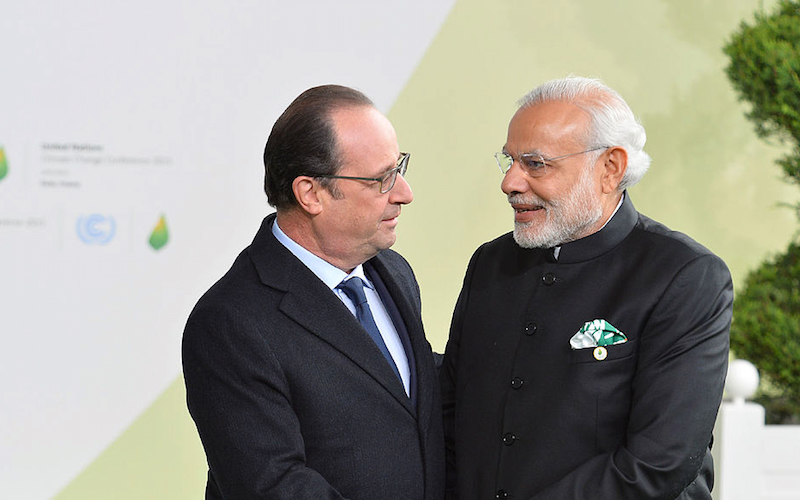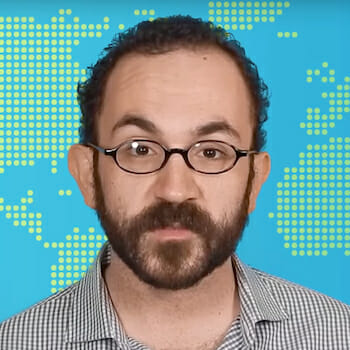
Modi’s Quest to Achieve India’s Great Power Status
Indian Prime Minister Modi invited French President Hollande to be the guest of honor at India’s Republic Day Celebrations in New Delhi last month. The seat is generally reserved for, and used by the office of the Prime Minister as, a signal of close and important state ties. Last year President Obama was Modi’s guest, which served as the start for a banner year of U.S.-India cooperation, on a broad range of economic, climate, and defense issues. Among others, Washington and New Delhi signed agreements aimed at developing India’s next generation aircraft carrier — an overt signal of joint concern about China’s emerging power in the Indian Ocean and, by extension, the South China Sea. Hollande’s presence is expected to have a similar result, particularly given that it is the world’s fourth largest arms exporter.
India has demonstrated that it has partners in multiple international camps. Some observers expected this year’s guest to be either Pakistan’s Prime Minister Sharif or perhaps even President Putin, to re-emphasize India’s historical orientation toward non-alignment. Thus far, Modi has signaled that India will remained non-aligned, but with the world’s most important arms exporters. In choosing Hollande this year, India may be shedding the strategic ambiguity that has long characterized its foreign policy, and starting to take steps that will ultimately result in it becoming a greater power in our G-Zero world.
As the second-most populous country in the world and its largest democracy, and having a young, energetic and impatient population that yearns to join the ranks of the world’s leading economies, India has all the basic prerequisites to become a Great Power, at least in its own region.
Yet, for decades it has failed to live up to its potential, the result of a sclerotic government bureaucracy and extremely diverse ethnic, religious and linguistic composition. Having been founded on an anti-colonial platform, its founders’ distaste for imperial misadventures led to its membership in the Non-Aligned Movement, and modern India has historically been more interested in scolding Great Powers for hubris or exploitation than joining their ranks. Further, its post-independence poverty and self-defeating statist bureaucracy made it impossible for India to project power beyond its immediate periphery.
For decades, the Indian political and military class have remained obsessed (to the point of paranoia) about threats from Pakistan, twisting its entire geo-strategic architecture towards its northwest neighbor, hobbling any inclination to look elsewhere for geopolitical opportunities.
Though the Indian government had made small overtures aimed at opening up to the world since the 1990s, its strategic reorientation has accelerated dramatically since the election of Narendra Modi in 2014. New Delhi had, over time, become unnerved by a substantially more powerful and assertive China, which did not share India’s democratic values and was eager to make its presence strongly felt in India’s backyard. The Indian government began to more fully appreciate its relative lack of strategic options, brought on by years of neglect. Modi swiftly began to patch up relations with India’s immediate neighbors, notably Sri Lanka, with Modi becoming the first Indian Prime Minister to visit the island in 28 years. He has been acting with remarkable calm and resolve to improve ties with Pakistan, recently making an unannounced stopover in the country on the occasion of Sharif’s birthday. Modi has also made his presence known in Myanmar, where he has made clear India’s interest in being ‘in the room’ as the new democracy evolves.
This has all afforded Modi the diplomatic space to begin to look farther afield for partnerships with other powers who support the idea of a more regionally-powerful India, and he has done so with enthusiasm. Obama’s presence at the Republic Day Parade was the start of a year of intense Indo-U.S. friendship, which saw a reciprocal visit by Modi to the U.S., a renewal of a nuclear agreement between the two states, and a visit by U.S. Defense Secretary Ash Carter to New Delhi, during which the U.S. indicated a willingness to transfer sensitive aircraft carrier technology to the Indian naval program. Coming on the heels of the Bush Administration’s 123 Agreement, which enhanced India’s civil nuclear program, Indian/U.S. relations have never been stronger.
At the same time, India began strengthening regional ties with Australia and Japan, who share India’s concern about China’s regional ambitions, and formalized procedures for joining them in recurring naval exercises in the Indian and Pacific Oceans, along with the U.S. Think tanks in New Delhi now write openly and regularly of the need to counter China’s growing presence, and the threat posed to Indian interests by Beijing. That said, India clearly still desires to keep more options open than closed.
It should be remembered that Modi also visited Russia and China last year, which, along with all his other travels, has already made him the most-traveled Indian Prime Minister in history. There was a good deal of speculation that Xi Jinping or Vladimir Putin might be Modi’s honored guest this year, making clear to the world that India was still a swing player, not beholden to any single camp. Modi is hedging his bets, however — in essence extending hands of friendship to a wide variety of potential partners while keeping a clenched fist behind his back. India’s historical political, economic and military ties to Russia remain firmly intact. Its growing defense budget continues to source a good deal of materiel from Russia, and the two countries have ambitions to achieve a trade relationship worth $30 billion by 2025.
Modi used Hollande’s visit to very publicly sign a deal for 36 Rafale fighter jets for the Indian Air Force (beating a Russian proposal for Sukhoi jets), as well as extend a 2006 defense cooperation agreement, and, in a historic first, invited a French contingent to march with Indian troops in the event. The message was not ambiguous. So while India’s strategic architecture remains small for a country of its size, the task of transitioning to Great Power status remains enormous, and the possibility for its derailment remains real. Much remains to be done.
Modi has, however, made clear by his repeated overtures to a series of strategic potential allies, that India is and wants to remain at the table. India’s new strategic thinking is coming into focus. For the first time, it is reasonable to imagine that a contingent of the Indian Brigade of the Guards could march down the Champs Elysees during Bastille Day. Modi’s message is clear: the days of strategic ambiguity will remain, but there is no ambiguity about its long-term economic, political, and military ambitions. While India is not Russia or the U.S. in terms of its global reach or strength, it is, apart from China, the emerging country with the most potential to achieve Great Power status this century. It will take a great deal of concerted reform, persistent effort, and devoted financial and military resources to achieve that, but Modi has set India on that path.
This article was originally posted in The Huffington Post.


